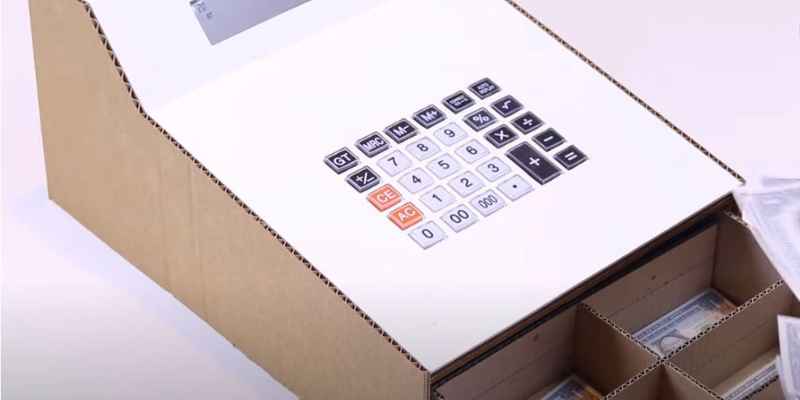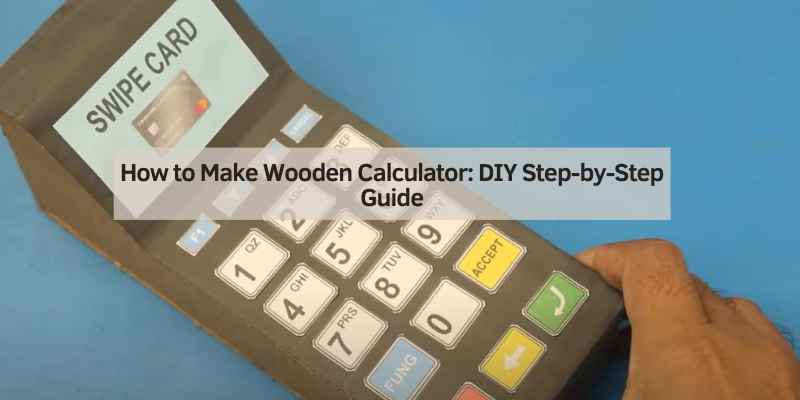To make a wooden calculator, gather the necessary materials and tools, measure and cut the wooden pieces, assemble the buttons and display panel, and connect the wiring components in a logical manner. Sand and finish the calculator for a polished look.
Gathering Materials
To create a unique and charming wooden calculator, you’ll need to gather a few specific materials. In this section, we’ll break down the materials into two categories: wooden panels and calculator components. Let’s dive in!
Wooden Panels
Since we’re focusing on creating a wooden calculator, finding suitable wooden panels is the first step. Look for plywood or MDF sheets that are at least ½ inch thick. These panels provide the necessary stability and strength for the calculator’s body. Make sure they are large enough to accommodate the dimensions of your calculator design. Measure twice to be certain!
Calculator Components
Now that you have the wooden panels sorted out, it’s time to think about the calculator components. Here’s a list of the key components you’ll need:
- Calculator Circuitry: This is the most crucial component, as it forms the core of your wooden calculator. You can purchase a calculator circuit board online or repurpose it from an old calculator.
- Buttons and Keycaps: Look for durable and responsive calculator buttons and keycaps. You can find these in electronics stores or salvage them from old calculators.
- LED Display: Choose a suitable LED display module that fits your calculator design. Ensure it’s compatible with the calculator circuit board you’re using.
- Battery Power Source: To make your calculator portable, you’ll need a battery power source. Look for a small rechargeable battery pack that can provide adequate power.
- Wires and Soldering Tools: Purchase wire cutters, strippers, and a soldering iron to connect the components effectively.
Once you have all these materials ready, you’re on your way to crafting a wooden calculator that stands out. In the next section, we’ll move on to the exciting process of designing and assembling your wooden calculator!
Preparing The Wood
Before you can start building your wooden calculator, it is important to prepare the wood properly. This involves cutting and sanding the wood to ensure it is the right size and shape for your project. It is also essential to measure the wood precisely to ensure accuracy and precision in your calculations. In this section, we will discuss the steps involved in preparing the wood for your wooden calculator.
Cutting And Sanding
The first step in preparing the wood is cutting it to the desired dimensions. Measure the length, width, and thickness of the wood, and mark the measurements using a pencil. Make sure to use a ruler or measuring tape for accurate measurements. Once the measurements are marked, use a saw to carefully cut the wood along the marked lines. Remember to wear safety goggles and use caution when operating the saw.
After cutting the wood, it is essential to sand it to smooth out any rough edges or surfaces. Use sandpaper with a fine grit to achieve a smooth finish. Begin by sanding the cut edges to remove any splinters or unevenness. Then, work your way across the entire surface of the wood, applying even pressure and using a back-and-forth motion. This step will give your wooden calculator a professional look and feel.
Measuring For Precision
Accurate measurements are crucial for a functional wooden calculator. To ensure precision, use a ruler or measuring tape to measure the length, width, and thickness of the wood. Make sure to measure from one end to the other, keeping the tape or ruler straight and aligned with the edges of the wood. It is also helpful to make multiple measurements and take the average to minimize errors.
In addition to overall dimensions, it is crucial to measure and mark the positions for buttons, display screens, and other components of the calculator. Use a measuring tape or ruler to mark the exact locations where these elements will be placed. This step will help you maintain symmetry and alignment throughout the construction process.
By carefully cutting and sanding the wood and measuring for precision, you are laying the foundation for a successful wooden calculator project. These initial steps are critical for ensuring the wood is the right size and shape and that your calculations will be accurate. In the next section, we will discuss the assembly process and how to bring your wooden calculator to life.
Assembling The Frame
Assembling the frame of a wooden calculator is an essential step in creating this functional and stylish piece. The frame provides the structure and support for the components, ensuring that the calculator is durable and accurately assembled.
Creating The Base
To start assembling the frame, create the base by cutting a piece of sturdy wood to the desired dimensions using a saw. Ensure the base is smooth and level to provide a stable foundation for the calculator.
Attaching Side Panels
Next, attach the side panels to the base using wood glue and screws. Position the panels evenly on each side of the base, ensuring they are securely fastened for stability.
Installation Of Calculator Components
Placing The Display
First, position the display module carefully on the wooden base.
- Ensure the display aligns perfectly with the designated area.
- Use a screwdriver to securely attach the display in place.
Inserting The Keypad
Next, gently insert the keypad onto the wooden surface following these steps:
- Place the keypad in the correct position on the calculator.
- Check for any obstructions that may hinder the keypad installation.
- Press down firmly to ensure the keypad is securely in place.
Testing And Calibration
Testing and Calibration are crucial steps in ensuring the accuracy and functionality of your wooden calculator.
Powering On
Before beginning the testing process, make sure to power on the wooden calculator and allow it to warm up.
Checking Functionality
To verify accurate functionality, press each digit and basic function buttons systematically.
If any button appears unresponsive, double-check the wiring and connections within the wooden calculator.
Calibrate the calculator according to the user manual to ensure precise calculations every time.
Adding Finishing Touches
As you near completion of your wooden calculator project, it’s time to add the finishing touches that will truly make it your own. From sealing the wood to personalizing the design, these steps will elevate your creation to a new level of uniqueness and functionality.
Sealing The Wood
To ensure the longevity of your wooden calculator, sealing the wood is essential. Before applying any finish, make sure the surface is smooth and free from any debris or dust particles. Use a sandpaper to smoothen the wood and then wipe it clean with a damp cloth. You can then proceed to apply a wood sealant to protect the surface from moisture and wear.
Personalizing The Design
Personalizing the design of your wooden calculator adds a special touch that truly makes it yours. Consider engraving your name or a meaningful symbol onto the surface. Additionally, you can use wood-burning tools to add intricate designs or patterns that reflect your unique style.

Frequently Asked Questions Of How To Make Wooden Calculator
How Can I Create A Wooden Calculator At Home?
Creating a wooden calculator at home is a fun DIY project. You can gather materials like wood, buttons, and an electronic circuit. Cut the wood to size, assemble the circuit, and attach the buttons. Follow online tutorials for step-by-step guidance.
What Are The Benefits Of Making A Wooden Calculator?
Making a wooden calculator allows you to personalize a functional device to your taste. It enhances your woodworking skills, fosters creativity, and provides a unique and eco-friendly way to perform calculations. It can also serve as a decorative and practical piece.
Are There Different Designs For Wooden Calculators?
Yes, wooden calculators come in various designs ranging from sleek and modern to rustic and vintage. You can choose a design that matches your style and preferences, whether you prefer a minimalist look or a more intricate design with decorative elements.
Online resources offer design inspiration and templates for customization.
Conclusion
Creating a wooden calculator is a fun and rewarding project that requires some basic woodworking skills. By following the step-by-step instructions and being creative with the design, you can make a unique and practical addition to your desk. With the right tools and patience, you can enjoy the satisfaction of building a functional wooden calculator that showcases your craftsmanship.


